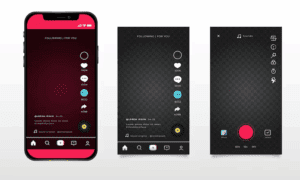You spent three hours perfecting the transitions, timing the audio sync, and grading the colors. Your video builds momentum on TikTok, and naturally, you want to share that success on Instagram Reels or YouTube Shorts. You hit “Save Video,” only to find the result cluttered with a bouncing logo and a username stamp that obscures your hard work.
The platform’s native watermark serves a distinct purpose: brand ubiquity. Every shared video becomes a billboard for TikTok. For creators, social media managers, and archivists, however, this branding feature is a bug. It lowers aesthetic quality, triggers algorithm penalties on competing platforms (Instagram notoriously down-ranks watermarked content), and ruins professional portfolios.
This technical limitation has fueled the rise of the tiktok downloader no watermark ecosystem – a suite of tools designed to fetch the raw master file directly from the server. But the difference between a grainy, compressed file and a pristine 1080p download lies in the code handling the extraction.
The Under-the-Hood Mechanics: How Extraction Works
Understanding how these tools function helps you distinguish between a safe utility and a data-harvesting scam. Content on TikTok isn’t stored as a single, immutable file with a logo burned into it. Instead, the platform uses a dynamic assembly process.
The Architecture of a TikTok Video
When a creator uploads a video, TikTok’s servers store two distinct versions of the visual data:
- The Master Stream (play_addr): This is the clean, compressed video file exactly as it exists on the hosting server.
- The Rendered Overlay (download_addr): This is a command set that tells the app to apply a graphical layer (the logo and username) over the master stream during playback or export.
A standard tiktok downloader no watermark bypasses the app’s rendering instruction. When you paste a link into these tools, a server-side script parses the HTML of the TikTok page. It hunts for the specific API response – usually a JSON object – that contains the direct link to the Content Delivery Network (CDN) hosting the play_addr file.
Once the script isolates that URL, it initiates a transfer directly from TikTok’s CDN to your device. The watermark is never removed because it was never there to begin with; the tool simply accessed the file before the app could stamp it.
Client-Side vs. Server-Side Extraction
This distinction matters for your digital safety.
- Server-Side (Safe): You send a URL to a remote server. That server talks to TikTok, grabs the video, and passes it to you. Your IP address acts only as the recipient.
- Client-Side/Injection (Risky): Some browser extensions inject JavaScript directly into your active browser session to scrape the video. This technique is unstable and can potentially expose your browser cookies or session tokens to the extension developer.
Analyzing the Tool Landscape
Not all methods for securing a clean video are created equal. In 2025, you generally have three avenues to choose from, each with specific trade-offs regarding fidelity and convenience.
The Web-Based Converter (Recommended)
For 95% of users, web-based converters offer the optimal balance of speed and safety. These platforms require no installation, leaving no footprint on your hard drive. They operate smoothly on mobile browsers (Safari for iOS, Chrome for Android) and desktop environments alike.
Why this wins: The processing happens remotely. The tool handles the heavy lifting of parsing the constantly changing TikTok API structure. Advanced platforms like TikSaver focus on parsing the original MP4 container without re-encoding it, ensuring the file matches the source bitrate exactly. This method prevents the “generation loss” that occurs when you screen record a video.
Desktop Software Applications
Dedicated software suites (often marketed as “4K Video Downloaders”) claim to offer bulk downloading capabilities. While useful for backing up an entire profile at once, they often come with bloated installers. Unless you are archiving thousands of videos for data analysis, the risk of installing unknown executable files (.exe or .dmg) outweighs the benefit of batch processing.
Screen Recording (The “Dirty” Method)
Users often resort to iOS or Android screen recording features. This is technically the worst method for preservation.
- UI Elements: You capture the hearts, comments, and share buttons along with the video.
- Compression Double-Dipping: You are recording a compressed stream, which your phone then compresses again. The result is artifacts, banding in gradients, and muddy audio.
Technical Deep Dive: Quality Metrics to Watch
A clean video is useless if it looks like it was filmed with a toaster. When evaluating a tiktok downloader no watermark, you should monitor specific file attributes.
Container Formats and Codecs
TikTok predominantly uses the H.264 (AVC) video codec inside an MP4 container. This legacy standard ensures maximum compatibility across billions of devices. However, some high-resolution uploads from newer smartphones utilize H.265 (HEVC) for better efficiency.
A quality downloader detects the source codec and preserves it. Inferior tools might transcode an HEVC file back to H.264 to save bandwidth on their end, causing a loss of dynamic range. When you download a file, check the info (Command+I on Mac, Properties on Windows). If the file size is significantly smaller than 5MB for a 60-second clip, aggressive re-compression has likely occurred.
Audio Bitrate Fidelity
TikTok audio is often arguably more important than the visual component. The platform normalizes audio loudness (LUFS) but supports decent bitrate transmission.
- Standard Extraction: Should yield AAC audio at ~128kbps.
- Poor Extraction: Simulates the “preview” stream, capping audio at 64kbps or mono channels.
If your downloaded video sounds “tinny” or lacks bass compared to the in-app playback, the downloader is scraping the wrong audio stream.
| Attribute | Standard Quality | High Quality / Original |
| Resolution | 720p (1280×720) | 1080p (1920×1080) |
| Frame Rate | 30 fps | 60 fps (if source supported) |
| Audio Codec | AAC-LC | AAC-HE |
| Bitrate | < 1000 kbps | 2500 – 5000 kbps |
Step-by-Step: The Safer Workflow
Navigating the download process requires a few precise steps to ensure you get the file, not a popup ad.
- Copy the Link Correctly: Inside TikTok, tap the “Share” arrow (or WhatsApp icon). Scroll past the initial contacts to find the “Copy Link” button. Do not use the URL from a web browser address bar if you are logged in, as it often contains session-specific tracking parameters (e.g., ?sender_device=mobile&sender_web_id=…).
- Paste and Parse: Navigate to your chosen tiktok downloader no watermark tool. Paste the clean link.
- Verify the Metadata: Before hitting the final download button, most reputable tools show a thumbnail preview. Check the duration and the caption. This confirms the API successfully located the correct video ID.
- Choose the Target: You will usually see options like “Download MP4” or “Download MP3”. Always prioritize “HD” or “Original Quality” if multiple servers are listed.
- Manage the File: On iOS, the file saves to the “Files” app by default. You must tap “Save Video” within the Files app to move it to your camera roll for editing. On Android, it typically lands directly in the Gallery/Downloads folder.
Legal and Ethical Boundaries
Technical capability does not imply legal immunity. The ability to use a tiktok downloader no watermark sits in a grey area governed by intent and jurisdiction.
The “Fair Use” Argument
In the United States, Fair Use allows for the use of copyrighted material for commentary, criticism, news reporting, or education.
- Example A: You download a viral clip to include in a YouTube video essay analyzing social trends. This is generally defensible under Fair Use.
- Example B: You download a viral clip, remove the watermark, and upload it to your own Instagram Reels to grow your account. This is copyright infringement.
Creator Rights
Creators own the copyright to their work the moment it is fixed in a digital medium. The watermark acts as a form of attribution. Removing it removes that attribution. If you are archiving content for personal reference (like a recipe or a workout routine), the legal risk is negligible. If you are repurposing content for a commercial account, the absence of a watermark does not protect you from DMCA takedowns.
Best Practice: If you want to repost someone else’s content, the most respectful (and legal) method is to DM them: “I love this video. Can I share it on my page with full credit?” Many creators will say yes, provided you tag them.
Troubleshooting Common Extraction Failures
Even the most robust API scrapers hit roadblocks. Here is how to diagnose specific errors when the download fails.
Private Account Restrictions
If a user has their account set to “Private,” the API cannot access the JSON data needed to retrieve the play_addr. The downloader will return an “Invalid URL” or “Video not found” error. There is no workaround for this that respects user privacy settings. You must follow the account and use a screen recorder (accepting the quality loss) if you absolutely need a personal copy.
Region-Locked Audio
TikTok licenses music geographically. A video using a specific track might be available in the UK but blocked in the US. If the downloader’s server plays the role of the requester and is located in a region where the audio is blocked, the download may fail or result in a muted video. Trying a different tool (which might route through a different server location) can sometimes resolve this.
The “Zero Byte” File
Occasionally, you might download a file that appears in your folder but refuses to play. This is usually a transmission error where the connection cut off before the header of the MP4 file was written. Simply deleting the file and retrying the process usually fixes the glitch.
The Future of Media Archiving
As we move deeper into the decade, the battle between platform retention and user data portability will intensify. Platforms like TikTok have a vested interest in keeping content inside their “walled garden.” We are likely to see increasingly complex obfuscation techniques intended to break third-party downloaders.
Developers of tiktok downloader no watermark tools are engaged in a constant game of cat-and-mouse. When TikTok updates its algorithm to scramble the play_addr locations, tools often go offline for 24-48 hours while developers reverse-engineer the new path.
Simultaneously, AI is entering the arena. New video in-painting technologies are emerging that can visually erase watermarks from the rendered video (download_addr) by predicting the pixels behind the logo. While impressive, this is visually destructive compared to retrieving the clean master file. The API interception method remains the gold standard for fidelity.
People Also Ask
Q: Can I download TikTok videos without a watermark on an iPhone? Yes. Use Safari to access a web-based downloader. Since iOS 13, Safari has a built-in Download Manager. Once downloaded, tap the Aa icon in the address bar > Downloads > tap the video > Share icon > Save Video.
Q: Does the creator know if I download their video without a watermark? No. The TikTok API registers the request as a standard “Share” or “View.” It does not report specifically that a third-party tool was used to strip the watermark.
Q: Is it illegal to use a TikTok downloader? The act of using the tool is not illegal. However, how you use the downloaded content can be. Personal archiving is generally safe; reposting without permission or for commercial gain violates copyright laws.
Q: Why do downloaded videos sometimes have the audio out of sync? This happens when a tool downloads the video and audio streams separately and fails to “mux” (combine) them perfectly. This is common with very long videos. Try a different tool or refresh the page to restart the session.
Q: Can I download Live streams? Generally, no. Live streams use a different protocol (HLS – HTTP Live Streaming) that is much harder to capture in real-time without specialized software. Most tools only work on VOD (Video on Demand) content.
The digital landscape requires high-fidelity assets. Whether you are a creator looking to cross-post your own footage or an archivist saving cultural moments, understanding the mechanism behind a tiktok downloader no watermark ensures you maintain the highest quality standards while navigating the necessary ethical boundaries. Clean video is not just about aesthetics; it is about preserving the integrity of the content source.



































